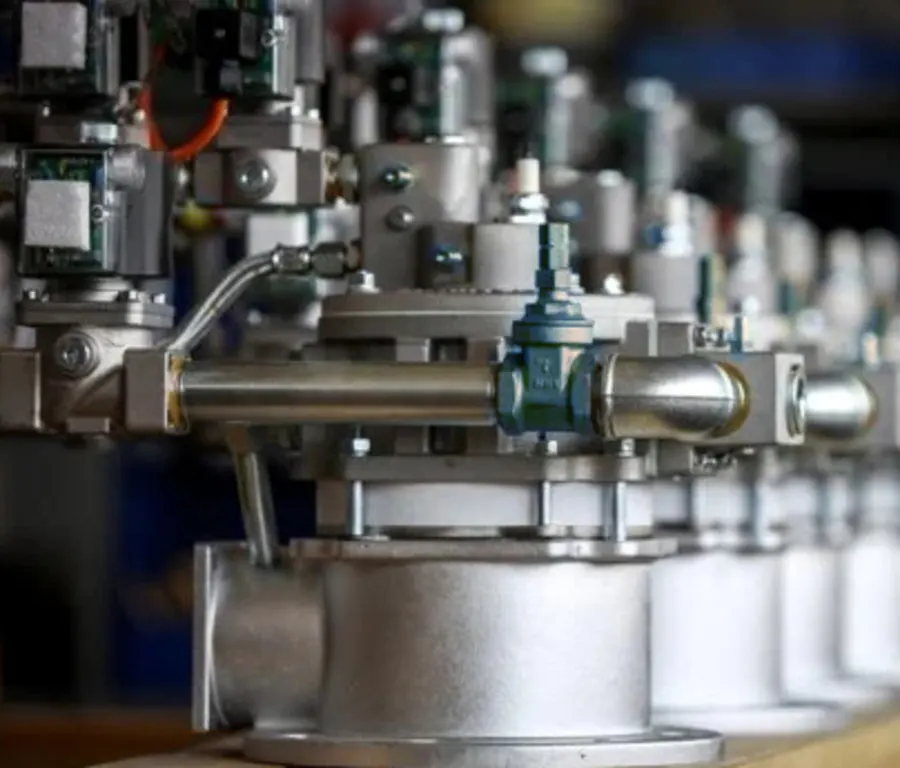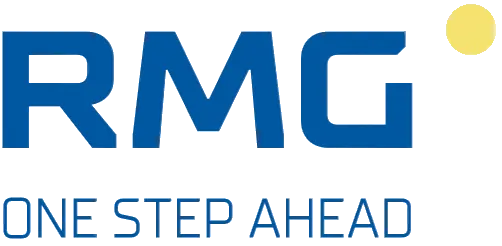Gas burner systems
A gas burner system converts gas efficiently into heat and enables precise control for a wide range of output requirements. Smaller burners up to around 10 MW are usually designed as monobloc burners, where the combustion air fan is integrated directly into the burner. Larger systems, on the other hand, use external fans and often separate pilot burners for reliable initial ignition at higher outputs.
For smaller burners (< 1 MW), a simple, two-stage control system is usually used, which is activated depending on the steam pressure in the boiler. Continuously controlled, modulated burners are used for higher outputs. Modern systems rely on an electronic control system that uses electrical control valves for the gas and air supply instead of a mechanical connection valve. These are optimally adjusted and monitored by a burner control system to ensure safety and efficiency.
The use of the RGQ 5 from RMG optimizes the functionality of gas burner systems. The RGQ 5 is used to determine gas quality by precisely determining key parameters such as calorific value, methane number and Wobbe index . This data is integrated directly into the burner control system, whereby the fuel-air ratio is dynamically adjusted based on the current gas composition. This minimizes exhaust gas losses, increases efficiency and improves process reliability.
Special gas burners, such as porous burners, work with catalytic converters and thus reduce nitrogen oxide emissions while increasing heat yield. The integration of the RGQ 5 into such systems enables even more precise control and contributes to the optimization of emission control.
For smaller burners (< 1 MW), a simple, two-stage control system is usually used, which is activated depending on the steam pressure in the boiler. Continuously controlled, modulated burners are used for higher outputs. Modern systems rely on an electronic control system that uses electrical control valves for the gas and air supply instead of a mechanical connection valve. These are optimally adjusted and monitored by a burner control system to ensure safety and efficiency.
The use of the RGQ 5 from RMG optimizes the functionality of gas burner systems. The RGQ 5 is used to determine gas quality by precisely determining key parameters such as calorific value, methane number and Wobbe index . This data is integrated directly into the burner control system, whereby the fuel-air ratio is dynamically adjusted based on the current gas composition. This minimizes exhaust gas losses, increases efficiency and improves process reliability.
Special gas burners, such as porous burners, work with catalytic converters and thus reduce nitrogen oxide emissions while increasing heat yield. The integration of the RGQ 5 into such systems enables even more precise control and contributes to the optimization of emission control.
Efficient combustion
CE-certified safety
Robust and durable
Modulable power
Low emissions
Versatile application

Gas burner systems for thermal processing plants
Gas burner systems for industrial furnaces are central elements for industrial applications that enable precise control and analysis in gas measurement technology. These systems are operated by gas appliances that work with gaseous fuels and comply with strict European and German safety standards. Gas systems for industry bear a CE mark and must meet the installation and connection conditions as well as the requirements for the appliance category in accordance with DIN EN 437. This classification includes the appropriate type of gas and the required distribution pressures.
The output of gas burner systems with control technology varies depending on the nominal load, which can be set between minimum and maximum heat input. While the nominal load describes the input power, the nominal output refers to the actual output power of the burner systems.
By integrating the RGQ 5 , the gas quality is analyzed in real time, allowing the modulated control of the burners to be matched even more precisely to the specific composition of the fuel. The calorific value measurement, the determination of the methane number and the Wobbe index enable flexible adaptation to varying gas compositions and ensure efficient and safe combustion.
Industrial combustion technology with gas burners in industrial system solutions ranges from heat treatment processes to analytical gas measurement techniques. With the support of the RGQ 5, burner controls can be continuously optimized, increasing efficiency and reducing exhaust gas emissions. This is particularly important in energy-intensive industries in order to reduce costs and meet environmental standards.
The output of gas burner systems with control technology varies depending on the nominal load, which can be set between minimum and maximum heat input. While the nominal load describes the input power, the nominal output refers to the actual output power of the burner systems.
By integrating the RGQ 5 , the gas quality is analyzed in real time, allowing the modulated control of the burners to be matched even more precisely to the specific composition of the fuel. The calorific value measurement, the determination of the methane number and the Wobbe index enable flexible adaptation to varying gas compositions and ensure efficient and safe combustion.
Industrial combustion technology with gas burners in industrial system solutions ranges from heat treatment processes to analytical gas measurement techniques. With the support of the RGQ 5, burner controls can be continuously optimized, increasing efficiency and reducing exhaust gas emissions. This is particularly important in energy-intensive industries in order to reduce costs and meet environmental standards.
Optimized combustion in a gas burner system for maximum energy
Gas burner systems offer a number of advantages that make them an ideal choice for industrial applications. One of the biggest advantages is their high efficiency. Optimized combustion extracts maximum energy from the fuel, keeping operating costs low. Gas burner systems are also CE-certified and meet all European and German safety requirements, ensuring reliable and safe use.
Technically, gas burner systems impress with modulable output settings that enable precise adjustment to different load requirements. Two-stage systems are available for smaller applications, while larger systems cover a wide range of outputs thanks to continuously adjustable controls. State-of-the-art electronic controls ensure an exact fuel-air ratio. This ratio is additionally optimized by superimposed O₂ and CO controls, which increases combustion efficiency and reduces emissions.
Other technical features include powerful fans with frequency control for an energy-efficient air supply and specially developed burners for minimal nitrogen oxide emissions. As a result, gas burner systems are not only durable and robustly designed for continuous operation, but also offer an environmentally friendly solution for heat treatment and gas measurement technology in a wide range of industrial sectors.
Technically, gas burner systems impress with modulable output settings that enable precise adjustment to different load requirements. Two-stage systems are available for smaller applications, while larger systems cover a wide range of outputs thanks to continuously adjustable controls. State-of-the-art electronic controls ensure an exact fuel-air ratio. This ratio is additionally optimized by superimposed O₂ and CO controls, which increases combustion efficiency and reduces emissions.
Other technical features include powerful fans with frequency control for an energy-efficient air supply and specially developed burners for minimal nitrogen oxide emissions. As a result, gas burner systems are not only durable and robustly designed for continuous operation, but also offer an environmentally friendly solution for heat treatment and gas measurement technology in a wide range of industrial sectors.
Important questions and answers about lathes
A modern gas burner system is at the heart of many thermal processes. It ensures precise, safe and energy-efficient heat supply. In this section, you will find out how a gas burner system works, what advantages it offers and what is important in terms of use, control and safety.
Do you have any questions about our
Gas burner systems
Feel free to contact us if you have any questions or need help. Our staff is always there for you.

